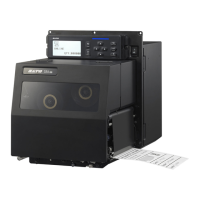90
Barcode Specification 9
In barcode specification, print of various barcode, change of bar width ratio, and print of guard bar or human-readable
information can be performed by designating (B, D, BD) after ESC.
This and the next page should be read closely and followed.
Refer to the table below for the specification of B, D, and BD.
[Specification of Bar Width Ratio]
Barcode
specification
parameter
(1) Bar width ratio
The barcode is composed of Narrow Bar, Wide Bar, Narrow Space and Wide Space. The Bar width ratio is the proportion of
Narrow Bar and Wide Bar.
Bar width ratio (Ratio 1 : 3) <B>
This barcode is composed of Narrow Bar [1] and Wide Bar [3].
Bar width ratio (Ratio 1 : 2) <D>
This barcode is composed of Narrow Bar [1] and Wide Bar [2].
Bar width ratio (Ratio 2 : 5) <BD>
This barcode is composed of Narrow Bar [2] and Wide Bar [5].
If the specifying bar width ratio for your own convenience, register the ratio with Bar Width Ratio <BT> and print labels with Print
of Specified Bar Width Ratio <BW>.
(2) Width of narrow bar and height of barcode
Narrow bar indicates the narrow bar width, and bar height indicates the height of the barcode.
For instance, printing narrow bar for 1 dot in head density of 8 dots/mm (203dpi), the narrow bar width will be 0.125mm and
barcode scanner may have a reading problem. To avoid this problem, set the narrow bar to 2 dots so that the narrow bar width
will be 0.25mm and this will improve the scanner reading condition.
There is a necessity to set the narrow bar width based on the printer head density or performance of barcode scanner.
In bar width ratio, [Narrow bar width] specification sets the width of the bar.
e.g.) When bar width ratio = 1 : 3 and narrow bar width is 3 dots, bar width ratio becomes 3 : 9.
Bar height is to specify the height of the barcode, and proper height based on the scanner type can be set.
(3) Intercharacter gap
Intercharacter gap is the space between two adjacent barcode characters in a discrete barcode.
To specify and enable intercharacter gap, insert Character Pitch <P> right before barcode specification such as <B>,<D> and
<BD> or Print of Barcode with Registered Ratio <BW>. If not, initial value (2 dots) will be set.
Intercharacter gap is designable for the following barcodes.
1) CODABAR (NW-7)
2) CODE 39
3) Industrial 2 of 5
4) Matrix 2 of 5
Intercharacter gap is the multiplier of values specified with Character Pitch <P> and narrow bar width.
e.g.) When Character Pitch <P> is 3 and narrow bar width is 2 dots:
Intercharacter gap = 3 x 2 = 6 (dots)

